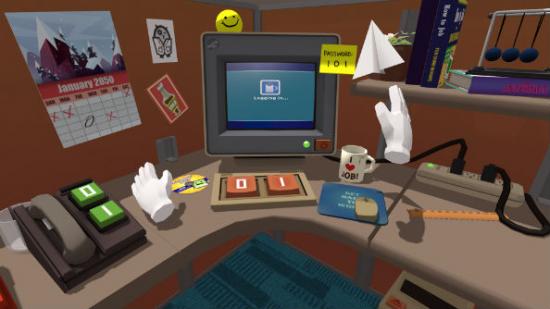Set against familiar settings but with comedic overtones, Job Simulator will be SteamVR’s first game. It’s purposefully designed to be tongue-in-cheek, however there’s a lot more to its makeup than might first meet the eye, according to developer Owlchemy Labs’ CEO Alex Schwartz.
There’s a good few of our best PC games I’d like to see get VR implementation.
While Job Simulator is mostly about having fun at your desk, there’s much more to making the entire experience believable. Whereas other non-VR games might ask you to simply hit a button to engage certain prompts, VR demands that you actually execute the movements otherwise they become less believable, explains Schwartz in an interview with Gamasutra.
“We realized it’s all about visceral hand interaction and feeling like you’re doing the thing, rather than that being abstracted,” he says. “Videogames have always been about hitting a button, and there’s always been some sort of delta between what I do and what actually happens.
“‘Oh there’s a ‘crouch button’, and [you push that] then the character crouches. Now, you just fucking crouch! [In VR], everything has to be the thing that you do, and we’re trying to remove as much abstraction from everything.”
Schwartz says playtesting has been particularly difficult in developing Job Simulator because once one player has played through a job once, they then understand it. Which means Owlchemy then need to move onto the next person to ensure they in turn understand it first time too, and so on and so forth.
With VR, Schwartz also notes that his attitude to design needs to be different from other non-VR developers, as any idea that might sound good on paper might fall on its face when prototyped. If the idea doesn’t work in conjunction with actual real life movements and the virtual reality headset, then it can’t work at all.
“You can never know how good something’s going to be in VR until you try it out with a headset, with your hands, and it either clicks or it doesn’t,” says Schwartz. “As we design, it’s first about what feels really hands-on, and second, it’s about whether people are really going to understand it. Because if we design an appliance or something, and then people read it in their mind as ‘Ok, how do I do this?’ and then they reach for the wrong thing or it’s not working ‘right’, we have to go iterate on that.
“It’s pretty much like little kid’s toys, or a Little Tikes version of a thing, because that’s really what you’re like in VR – you got these mitts and you’re just smacking things like a kid does [laughs]. So we really have to simplify things into the basic core interactions.”
Thanks, Gamasutra.
